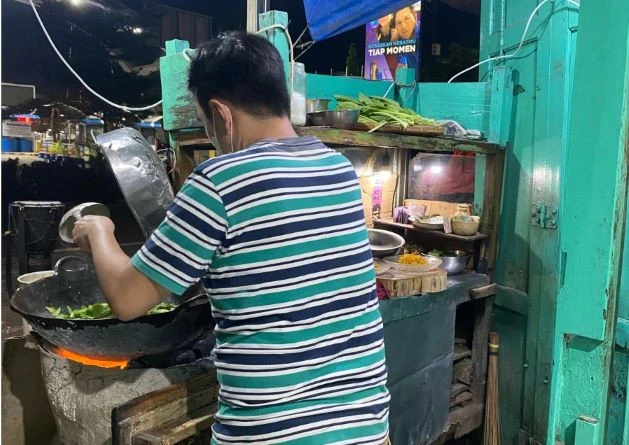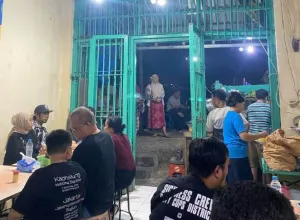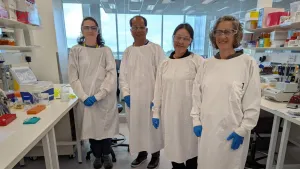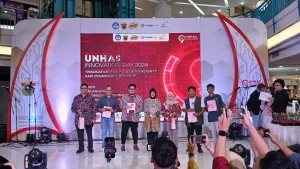MAKASSAR, UNHAS.TV - Dry noodles, a typical Makassar culinary delight that is mouth-watering, have become an inseparable part of South Sulawesi's culinary culture. Behind its savory taste and crunchy texture, there is an interesting story about Angko Tjao, a pioneer who laid the foundation for the popularity of this dish.
This article will explore the history of dry noodles, how Angko Tjao started it, and the legacy that continues to this day. The story of dry noodles began around the 1950s in the Chinatown area of Makassar, when a Chinese descendant named Angko Tjao began selling Chinese food from a simple cart on the side of Jalan Bali.

MIE HENGKI - Food processing at Mie Hengki, Jalan Nusantara, Makassar City. Photos: Faizal A Saud.
Angko Tjao, who is known to be friendly and communicative, offers three types of noodle dishes: fried noodles, Hokkian noodles, and Kwantong noodles. All three are typical Chinese dishes that were already popular among the local community at that time.
However, Angko Tjao's uniqueness lies in his sensitivity to customer tastes. He often received special requests, and this is where the origin of dry noodles was born. One customer asked for Kwantong noodles to be served in a different way: fried noodles until crispy and drizzled with a thick sauce that was separated.
Initially, this request only came from one person, but gradually more and more customers liked this innovation. Seeing this enthusiasm, Angko Tjao began to develop a recipe for dry fried noodles with thick sauce as a new menu, which eventually became known as "dry noodles."
At that time, dry noodles were not just food, but also a reflection of the acculturation of Chinese and Makassar cultures. The noodles are fried until crispy, giving them a unique texture, while the thick sauce—made from chicken stock, cornstarch, eggs, and various spices—adds a distinctive savory flavor. The dish is usually served with sliced chicken, shrimp, meatballs, mustard greens, and sometimes liver or squid, making it a rich and filling dish.
Angko Tjao’s success is inseparable from his personal approach. He always pays attention to details, such as the level of doneness of the noodles or the thickness of the sauce, according to the customer’s taste. The popularity of dry noodles skyrocketed, and his small cart on Jalan Bali became a destination for Makassar residents who wanted to enjoy this dish.
Seeing the increasing demand, Angko Tjao finally opened a permanent stall, marking the first step of dry noodles as a culinary specialty of the city. "So Angko Tjao was a worker at a temple on the corner of Jalan Bali - Jalan Sulawesi, then got a (official) house like a terraced house on Jalan Bali, behind Toko Ance Meong alias Toko Sinar Buana. From here he started pioneering the dry noodle business," said Faizal A Saud, a history activist of Makassar City. According to the Unhas Accounting alumnus, it was from this house that he developed his business to the present stage.
Legacy for the Next Generation
After Angko Tjao passed away, his culinary recipes and passion were continued by his three children: Titi, Hengki, and Awa. Each of them founded a dry noodle stall with their own names, namely Mie Titi, Mie Hengki, and Mie Awa.
In addition, a brother-in-law of the family, Anto, also opened a stall which is now known as Mie Anto. Anto is married to Amoy, the daughter of Angko Tjao. Later Amoy made her own stall with the name Mie Amoy after separating from Anto. Meanwhile, Mie Anto remains with that name.
Mie Titi, Mie Hengki, and Mie Awa also became the pioneers of dry noodles in Makassar, each with its own characteristics. Mie Titi expanded further by opening several branches in other places. Meanwhile, Mie Hengki remains at its first location on Jalan Nusantara in front of the Makassar Harbor gate and is adamant about not opening any branches.
Mie Titi: Becoming the most famous and having many branches, even outside Makassar. The name "Titi" comes from Angko Tjao's nickname for his youngest child, which means "little brother" in Chinese. Mie Titi is known for its generous portions and variety of toppings such as shrimp and seafood.
Mie Hengki: Choosing to stay with one location on Jalan Nusantara, Mie Hengki maintains a traditional atmosphere with a simple green-painted building and classic cooking equipment, such as a large frying pan and charcoal stove. At one time, Mie Hengki was famous for its unique characteristics: the radio broadcast that was often played in the stall was Radio Mercurius.
The noodles here are known for their slightly thicker and crunchy texture. Another unique feature is that the food is only cooked after an order is placed. This is what makes customers have to be more patient waiting for their orders.
Mie Awa: Located on Jalan Sulawesi, Mie Awa has several branches and offers a variety of menus, such as noodle soup, noodle dipping, and even manohara noodles inspired by special customer requests. Awa is the name of Angko Tjao's son who continued the business in a different location.
Mie Anto/Amoy: Operating on Jalan Lombok without any branches, this stall remains loyal to the original recipe with a simple yet authentic touch.
Although these four stalls operate independently, they all inherit Angko Tjao's core recipe: crispy fried noodles, thick, savory sauce, and presentation that pays attention to detail. Mie Titi, in particular, is often equated with dry noodles in general due to its popularity, much like a brand that has become a generic name.
Characteristics and Attractions of Dry Noodles
Makassar dry noodles are different from other noodle dishes, such as Chinese ifumie, because the noodles are thinner and have a very crispy texture. The process of making them requires patience: the noodles are soaked briefly, fried until dry, then doused in hot sauce made to order. The sauce usually contains a mixture of vegetables, meat, and seafood, with the addition of lime and chili sauce to balance the flavors.
Another uniqueness is the way it is served. Some stalls serve the noodles and sauce separately, allowing customers to adjust the softness of the noodles themselves. The use of charcoal stoves in some stalls, such as Mie Hengki, also adds a distinctive aroma that is difficult to imitate with modern stoves.
"I am very familiar with the first original dry noodles in Makassar City in the past, cooked by the father of Titi, Awa, Hengki, and Amoy, named Angko Tjao, so I can compare the authenticity of the taste," said Faizal, who is often referred to as a "historical accountant" because he has studied the history of Makassar City a lot.
Dry Noodles in Makassar Culture
Dry noodles are not just food, but also a symbol of acculturation and diversity in Makassar. This dish reflects the fusion of Chinese culture with local tastes, where simple spices combine with fresh coastal ingredients. Its popularity has made it one of Makassar's culinary icons, alongside Makassar coto and konro soup.
To this day, Angko Tjao's successor stalls are still busy with visitors, both locals and tourists. Dry noodles are also starting to be known in other cities in Indonesia, such as Jakarta, proving its cross-generational appeal. Although times continue to change, Angko Tjao's recipe and story live on through every plate of dry noodles served.
The history of dry noodles is a story of innovation, hard work, and family heritage. Angko Tjao, with his simple cart, not only created a delicious dish but also left a strong cultural footprint in Makassar.
Through his children—Titi, Hengki, Awa, and the Anto family—dry noodles continue to grow, maintaining the authentic taste pioneered decades ago. For anyone visiting Makassar, tasting dry noodles is the best way to experience a piece of the city's culinary history and warmth.(*)





-300x169.webp)






